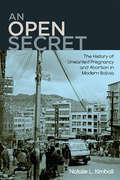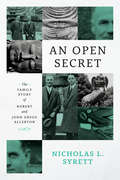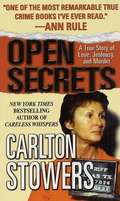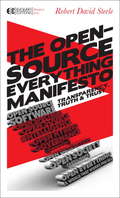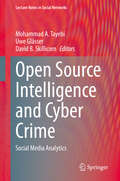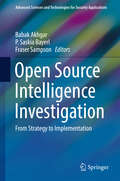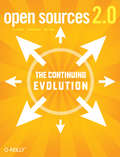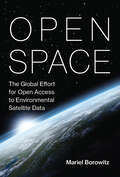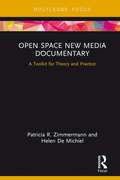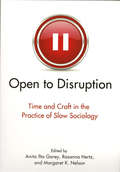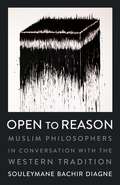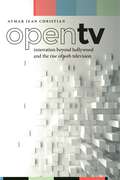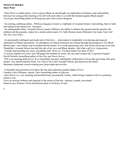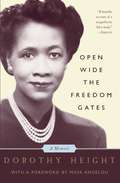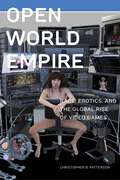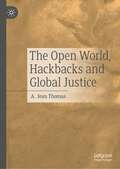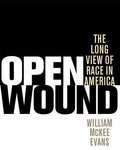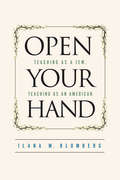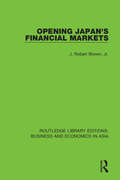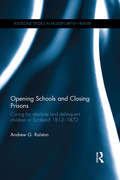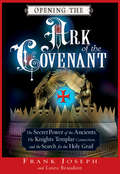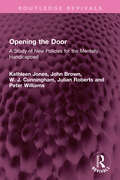- Table View
- List View
An Open Secret: The History of Unwanted Pregnancy and Abortion in Modern Bolivia
by Natalie L. KimballMany women throughout the world face the challenge of confronting an unexpected or an unwanted pregnancy, yet these experiences are often shrouded in silence. An Open Secret draws on personal interviews and medical records to uncover the history of women’s experiences with unwanted pregnancy and abortion in the South American country of Bolivia. This Andean nation is home to a diverse population of indigenous and mixed-race individuals who practice a range of medical traditions. Centering on the cities of La Paz and El Alto, the book explores how women decided whether to continue or terminate their pregnancies and the medical practices to which women recurred in their search for reproductive health care between the early 1950s and 2010. It demonstrates that, far from constituting private events with little impact on the public sphere, women’s intimate experiences with pregnancy contributed to changing policies and services in reproductive health in Bolivia.
An Open Secret: The Family Story of Robert and John Gregg Allerton
by Nicholas L. SyrettIn 1922 Robert Allerton—described by the Chicago Tribune as the “richest bachelor in Chicago”—met a twenty-two-year-old University of Illinois architecture student named John Gregg, who was twenty-six years his junior. Virtually inseparable from then on, they began publicly referring to one another as father and son within a couple years of meeting. In 1960, after nearly four decades together, and with Robert Allerton nearing ninety, they embarked on a daringly nonconformist move: Allerton legally adopted the sixty-year-old Gregg as his son, the first such adoption of an adult in Illinois history. An Open Secret tells the striking story of these two iconoclasts, locating them among their queer contemporaries and exploring why becoming father and son made a surprising kind of sense for a twentieth-century couple who had every monetary advantage but one glaring problem: they wanted to be together publicly in a society that did not tolerate their love. Deftly exploring the nature of their design, domestic, and philanthropic projects, Nicholas L. Syrett illuminates how viewing the Allertons as both a same-sex couple and an adopted family is crucial to understanding their relationship’s profound queerness. By digging deep into the lives of two men who operated largely as ciphers in their own time, he opens up provocative new lanes to consider the diversity of kinship ties in modern US history.
An Open Secret: The Family Story of Robert and John Gregg Allerton
by Nicholas L. SyrettIn 1922 Robert Allerton—described by the Chicago Tribune as the “richest bachelor in Chicago”—met a twenty-two-year-old University of Illinois architecture student named John Gregg, who was twenty-six years his junior. Virtually inseparable from then on, they began publicly referring to one another as father and son within a couple years of meeting. In 1960, after nearly four decades together, and with Robert Allerton nearing ninety, they embarked on a daringly nonconformist move: Allerton legally adopted the sixty-year-old Gregg as his son, the first such adoption of an adult in Illinois history. An Open Secret tells the striking story of these two iconoclasts, locating them among their queer contemporaries and exploring why becoming father and son made a surprising kind of sense for a twentieth-century couple who had every monetary advantage but one glaring problem: they wanted to be together publicly in a society that did not tolerate their love. Deftly exploring the nature of their design, domestic, and philanthropic projects, Nicholas L. Syrett illuminates how viewing the Allertons as both a same-sex couple and an adopted family is crucial to understanding their relationship’s profound queerness. By digging deep into the lives of two men who operated largely as ciphers in their own time, he opens up provocative new lanes to consider the diversity of kinship ties in modern US history.
An Open Secret: The Family Story of Robert and John Gregg Allerton
by Nicholas L. SyrettIn 1922 Robert Allerton—described by the Chicago Tribune as the “richest bachelor in Chicago”—met a twenty-two-year-old University of Illinois architecture student named John Gregg, who was twenty-six years his junior. Virtually inseparable from then on, they began publicly referring to one another as father and son within a couple years of meeting. In 1960, after nearly four decades together, and with Robert Allerton nearing ninety, they embarked on a daringly nonconformist move: Allerton legally adopted the sixty-year-old Gregg as his son, the first such adoption of an adult in Illinois history. An Open Secret tells the striking story of these two iconoclasts, locating them among their queer contemporaries and exploring why becoming father and son made a surprising kind of sense for a twentieth-century couple who had every monetary advantage but one glaring problem: they wanted to be together publicly in a society that did not tolerate their love. Deftly exploring the nature of their design, domestic, and philanthropic projects, Nicholas L. Syrett illuminates how viewing the Allertons as both a same-sex couple and an adopted family is crucial to understanding their relationship’s profound queerness. By digging deep into the lives of two men who operated largely as ciphers in their own time, he opens up provocative new lanes to consider the diversity of kinship ties in modern US history.
Open Secrets: A True Story of Love, Jealousy, and Murder
by Carlton StowersOn a fall afternoon in 1983, in an upscale Dallas suburb, Rozanne Gailiunas was found stripped, bound to her bed, and shot through the skull. Her four-year-old son has been napping peacefully in the next room when she was killed. Rozanne's husband, Dr. Peter Gailiunas--and her lover, Larry Aylor--immediately fell under suspicion. Until a surprise informant identified the mastermind behind the murder as Aylor's own wife, Joy--a woman so driven by jealousy and greed that she put out a contract on both Rozanne and later her own husband.On the run and managing to elude investigators for eight years, the two-year search for the socialite would eventually end in the south of France. There, authorities found the elusive femme fatale, living as comfortably among the world's elite as she was among hired killers. At last, the authorities' questions would be answered, to reveal a shocking insight into the heart of an unlikely killer, and a small-town Texas crime that made international headlines.
The Open-Source Everything Manifesto
by Robert David Steele Howard BloomWhat the world lacks right now--especially the United States, where every form of organization from government to banks to labor unions has betrayed the public trust--is integrity. Also lacking is public intelligence in the sense of decision-support: knowing what one needs to know in order to make honest decisions for the good of all, rather than corrupt decisions for the good of the few.The Open-Source Everything Manifesto is a distillation of author, strategist, analyst, and reformer Robert David Steele life's work: the transition from top-down secret command and control to a world of bottom-up, consensual, collective decision-making as a means to solve the major crises facing our world today. The book is intended to be a catalyst for citizen dialog and deliberation, and for inspiring the continued evolution of a nation in which all citizens realize our shared aspiration of direct democracy--informed participatory democracy. Open-Source Everything is a cultural and philosophical concept that is essential to creating a prosperous world at peace, a world that works for one hundred percent of humanity. The future of intelligence is not secret, not federal, and not expensive. It is about transparency, truth, and trust among our local to global collective. Only "open" is scalable. As we strive to recover from the closed world corruption and secrecy that has enabled massive fraud within governments, banks, corporations, and even non-profits and universities, this timely book is a manifesto for liberation--not just open technology, but open everything.From the Trade Paperback edition.sive and whether you agree with him or not, you cannot ignore what he says."
Open Source Intelligence and Cyber Crime: Social Media Analytics (Lecture Notes in Social Networks)
by Mohammad A. Tayebi Uwe Glässer David B. SkillicornThis book shows how open source intelligence can be a powerful tool for combating crime by linking local and global patterns to help understand how criminal activities are connected. Readers will encounter the latest advances in cutting-edge data mining, machine learning and predictive analytics combined with natural language processing and social network analysis to detect, disrupt, and neutralize cyber and physical threats. Chapters contain state-of-the-art social media analytics and open source intelligence research trends. This multidisciplinary volume will appeal to students, researchers, and professionals working in the fields of open source intelligence, cyber crime and social network analytics. Chapter Automated Text Analysis for Intelligence Purposes: A Psychological Operations Case Study is available open access under a Creative Commons Attribution 4.0 International License via link.springer.com.
Open Source Intelligence Investigation
by Babak Akhgar P. Saskia Bayerl Fraser SampsonOne of the most important aspects for a successful police operation is the ability for the police to obtain timely, reliable and actionable intelligence related to the investigation or incident at hand. Open Source Intelligence (OSINT) provides an invaluable avenue to access and collect such information in addition to traditional investigative techniques and information sources. This book offers an authoritative and accessible guide on how to conduct Open Source Intelligence investigations from data collection to analysis to the design and vetting of OSINT tools. In its pages the reader will find a comprehensive view into the newest methods for OSINT analytics and visualizations in combination with real-life case studies to showcase the application as well as the challenges of OSINT investigations across domains. Examples of OSINT range from information posted on social media as one of the most openly available means of accessing and gathering Open Source Intelligence to location data, OSINT obtained from the darkweb to combinations of OSINT with real-time analytical capabilities and closed sources. In addition it provides guidance on legal and ethical considerations making it relevant reading for practitioners as well as academics and students with a view to obtain thorough, first-hand knowledge from serving experts in the field.
Open Source Intelligence Investigation: From Strategy to Implementation (Advanced Sciences and Technologies for Security Applications)
by Babak Akhgar, P. Saskia Bayerl and Fraser SampsonOne of the most important aspects for a successful police operation is the ability for the police to obtain timely, reliable and actionable intelligence related to the investigation or incident at hand. Open Source Intelligence (OSINT) provides an invaluable avenue to access and collect such information in addition to traditional investigative techniques and information sources. This book offers an authoritative and accessible guide on how to conduct Open Source Intelligence investigations from data collection to analysis to the design and vetting of OSINT tools. In its pages the reader will find a comprehensive view into the newest methods for OSINT analytics and visualizations in combination with real-life case studies to showcase the application as well as the challenges of OSINT investigations across domains. Examples of OSINT range from information posted on social media as one of the most openly available means of accessing and gathering Open Source Intelligence to location data, OSINT obtained from the darkweb to combinations of OSINT with real-time analytical capabilities and closed sources. In addition it provides guidance on legal and ethical considerations making it relevant reading for practitioners as well as academics and students with a view to obtain thorough, first-hand knowledge from serving experts in the field.
Open Sources 2.0
by Chris Dibona Danese Cooper Mark StoneOpen Sources 2.0 is a collection of insightful and thought-provoking essays from today's technology leaders that continues painting the evolutionary picture that developed in the 1999 book Open Sources: Voices from the Revolution . These essays explore open source's impact on the software industry and reveal how open source concepts are infiltrating other areas of commerce and society. The essays appeal to a broad audience: the software developer will find thoughtful reflections on practices and methodology from leading open source developers like Jeremy Allison and Ben Laurie, while the business executive will find analyses of business strategies from the likes of Sleepycat co-founder and CEO Michael Olson and Open Source Business Conference founder Matt Asay. From China, Europe, India, and Brazil we get essays that describe the developing world's efforts to join the technology forefront and use open source to take control of its high tech destiny. For anyone with a strong interest in technology trends, these essays are a must-read. The enduring significance of open source goes well beyond high technology, however. At the heart of the new paradigm is network-enabled distributed collaboration: the growing impact of this model on all forms of online collaboration is fundamentally challenging our modern notion of community. What does the future hold? Veteran open source commentators Tim O'Reilly and Doc Searls offer their perspectives, as do leading open source scholars Steven Weber and Sonali Shah. Andrew Hessel traces the migration of open source ideas from computer technology to biotechnology, and Wikipedia co-founder Larry Sanger and Slashdot co-founder Jeff Bates provide frontline views of functioning, flourishing online collaborative communities. The power of collaboration, enabled by the internet and open source software, is changing the world in ways we can only begin to imagine.Open Sources 2.0 further develops the evolutionary picture that emerged in the original Open Sources and expounds on the transformative open source philosophy. "This is a wonderful collection of thoughts and examples by great minds from the free software movement, and is a must have for anyone who follows free software development and project histories." --Robin Monks, Free Software Magazine The list of contributors include Alolita Sharma Andrew Hessel Ben Laurie Boon-Lock Yeo Bruno Souza Chris DiBona Danese Cooper Doc Searls Eugene Kim Gregorio Robles Ian Murdock Jeff Bates Jeremy Allison Jesus M. Gonzalez-Barahona Kim Polese Larry Sanger Louisa Liu Mark Stone Mark Stone Matthew N. Asay Michael Olson Mitchell Baker Pamela Jones Robert Adkins Russ Nelson Sonali K. Shah Stephen R. Walli Steven Weber Sunil Saxena Tim O'Reilly Wendy Seltzer
Open Space: The Global Effort for Open Access to Environmental Satellite Data (Information Policy)
by Mariel BorowitzAn examination of environmental satellite data sharing policies, offering a model of data-sharing policy development, case and practical recommendations for increasing global data sharing.Key to understanding and addressing climate change is continuous and precise monitoring of environmental conditions. Satellites play an important role in collecting climate data, offering comprehensive global coverage that can't be matched by in situ observation. And yet, as Mariel Borowitz shows in this book, much satellite data is not freely available but restricted; this remains true despite the data-sharing advocacy of international organizations and a global open data movement. Borowitz examines policies governing the sharing of environmental satellite data, offering a model of data-sharing policy development and applying it in case studies from the United States, Europe, and Japan—countries responsible for nearly half of the unclassified government Earth observation satellites. Borowitz develops a model that centers on the government agency as the primary actor while taking into account the roles of such outside actors as other government officials and non-governmental actors, as well as the economic, security, and normative attributes of the data itself. The case studies include the U.S. National Aeronautics and Space Administration (NASA) and the U.S. National Oceanographic and Atmospheric Association (NOAA), and the United States Geological Survey (USGS); the European Space Agency (ESA) and the European Organization for the Exploitation of Meteorological Satellites (EUMETSAT); and the Japanese Aerospace Exploration Agency (JAXA) and the Japanese Meteorological Agency (JMA). Finally, she considers the policy implications of her findings for the future and provides recommendations on how to increase global sharing of satellite data.
Open Space New Media Documentary: A Toolkit for Theory and Practice (Routledge Studies in Media Theory and Practice)
by Patricia R. Zimmermann Helen De MichielOpen Space New Media Documentary examines an emerging and significant area of documentary practice in the twenty-first century: community-based new media documentary projects that move across platforms and utilize participatory modalities. The book offers an innovative theorization of these collaborative and collective new media practices, which the authors term "open space," gesturing towards a more contextual critical nexus of technology, form, histories, community, convenings, collaborations, and mobilities. It looks at a variety of low cost, sustainable and scalable documentary projects from across the globe, where new technologies meet places and people in Argentina, Canada, India, Indonesia, Peru, South Africa, Ukraine, and the USA.
Open to Disruption: Time and Craft in the Practice of Slow Sociology
by Rosanna Hertz Anita GareyAt a time when an emphasis on productivity in higher education threatens to undermine well-crafted research, these highly reflexive essays capture the sometimes profound intellectual effects that may accompany disrupted scholarship. They reveal that over long periods of time relationships with people studied invariably change, sometimes in dramatic ways. They illustrate how world events such as 9/11 and economic cycles impact individual biographies. Some researchers describe how disruptions prompted them to expand the boundaries of their discipline and invent concepts that could more accurately describe phenomena that previously had no name and no scholarly history. Sometimes scholars themselves caused the disruption as they circled back to work they had considered "done" and allowed the possibility of rethinking earlier findings.
Open to Reason: Muslim Philosophers in Conversation with the Western Tradition (Religion, Culture, and Public Life #36)
by Souleymane Bachir DiagneWhat does it mean to be a Muslim philosopher, or to philosophize in Islam? In Open to Reason, Souleymane Bachir Diagne traces Muslims’ intellectual and spiritual history of examining and questioning beliefs and arguments to show how Islamic philosophy has always engaged critically with texts and ideas both inside and outside its tradition. Through a rich reading of classical and modern Muslim philosophers, Diagne explains the long history of philosophy in the Islamic world and its relevance to crucial issues of our own time.From classical figures such as Avicenna to the twentieth-century Sufi master and teacher of tolerance Tierno Bokar Salif Tall, Diagne explores how Islamic thinkers have asked and answered such questions as Does religion need philosophy? How can religion coexist with rationalism? What does it mean to interpret a religious narrative philosophically? What does it mean to be human, and what are human beings’ responsibilities to nature? Is there such a thing as an “Islamic” state, or should Muslims reinvent political institutions that suit their own times? Diagne shows that philosophizing in Islam in its many forms throughout the centuries has meant a commitment to forward and open thinking. A remarkable history of philosophy in the Islamic world as well as a work of philosophy in its own right, this book seeks to contribute to the revival of a spirit of pluralism rooted in Muslim intellectual and spiritual traditions.
Open TV: Innovation beyond Hollywood and the Rise of Web Television (Postmillennial Pop #20)
by Aymar Jean ChristianHow the internet transformed television Before HBO’s hit show Insecure, Issa Rae’s comedy about being a nerdy black woman debuted as a YouTube web series The Misadventures of Awkward Black Girl, her response to the absence of diverse black characters on the small screen. Broad City, a feminist sitcom now on Comedy Central, originated as a web series on YouTube, developed directly out of funny women Ilana Glazer and Abbi Jacobson’s real-life friendship. These unconventional stories took advantage of the freedom afforded outside the traditional television system: online. Open TV shows how we have left “the network era” far behind and entered the networked era, with the web opening up new possibilities for independent producers, entrepreneurs, and media audiences. Based on interviews with writers, producers, show-runners, and network executives, visits to festivals and award shows, and the experience of producing his own series, Aymar Jean Christian argues that the web brought innovation to television by opening up series development to new producers, fans, and sponsors that had previously been excluded. Online access to distribution provides creative freedom for indie producers, allows for more diverse storytelling from marginalized communities, and introduces new ways of releasing and awarding shows. Open TV is essential reading for anyone interested in the changing environment of television and how the internet can inspire alternatives to what’s on TV tonight.
Open Water
by Nelson Caleb AzumahTwo young people meet at a pub in South East London. Both are Black British, both won scholarships to private schools where they struggled to belong, both are now artists - he a photographer, she a dancer - trying to make their mark in a city that by turns celebrates and rejects them. Tentatively, tenderly, they fall in love. But two people who seem destined to be together can still be torn apart by fear and violence.
Open Wide the Freedom Gates: A Memoir
by Dorothy Height"In her memoir, Dr. Height reflects on a life of service and leadership. We witness her childhood encounters with racism in her hometown of Rankin, Pennsylvania; the thrill of New York college life during the Harlem Renaissance; and her first battles as a young welfare caseworker during the Depression. We see her march through Times Square in protest against lynchings. We sit with her onstage as Dr. Martin Luther King, Jr. delivers his "I Have a Dream" speech. We meet the extraordinary people she knew intimately throughout the decades: W. E. B. DuBois, Marcus Garvey, Eleanor Roosevelt, Mary McLeod Bethune, Adam Clayton Powell Sr. , Langston Hughes, W. C. Handy, and many others. And we watch as she leads the National Council for Negro Women for forty-one years, working tirelessly to join people in the women's movement to those in Civil Rights Movement. " "After the fierce battles of the 1960s, Dr. Height focuses her attention on troubled black communities. She devotes her energies to organizing and educating at the grassroots, fighting to combat rural poverty, educate about AIDS, discourage teenage pregnancy, and promote black family values. In 1994, her efforts are officially recognized. Along with Rosa Parks, she receives the Presidential Medal of Freedom, the nation's highest civilian honor, from President Bill Clinton. "--BOOK JACKET. Title Summary field provided by Blackwell North America, Inc. All Rights Reserved
Open World Empire: Race, Erotics, and the Global Rise of Video Games (Postmillennial Pop #26)
by Christopher B. PattersonSeeking ways to understand video games beyond their imperial logics, Patterson turns to erotics to re-invigorate the potential passions and pleasures of playVideo games vastly outpace all other mediums of entertainment in revenue and in global reach. On the surface, games do not appear ideological, nor are they categorized as national products. Instead, they seem to reflect the open and uncontaminated reputation of information technology. Video games are undeniably imperial products. Their very existence has been conditioned upon the spread of militarized technology, the exploitation of already-existing labor and racial hierarchies in their manufacture, and the utopian promises of digital technology. Like literature and film before it, video games have become the main artistic expression of empire today: the open world empire, formed through the routes of information technology and the violences of drone combat, unending war, and overseas massacres that occur with little scandal or protest.Though often presented as purely technological feats, video games are also artistic projects, and as such, they allow us an understanding of how war and imperial violence proceed under signs of openness, transparency, and digital utopia. But the video game, as Christopher B. Patterson argues, is also an inherently Asian commodity: its hardware is assembled in Asia; its most talented e-sports players are of Asian origin; Nintendo, Sony, and Sega have defined and dominated the genre. Games draw on established discourses of Asia to provide an “Asiatic” space, a playful sphere of racial otherness that straddles notions of the queer, the exotic, the bizarre, and the erotic. Thinking through games like Overwatch, Call of Duty 4: Modern Warfare, Shenmue II, and Alien: Isolation, Patterson reads against empire by playing games erotically, as players do—seeing games as Asiatic playthings that afford new passions, pleasures, desires, and attachments.
The Open World, Hackbacks and Global Justice
by A. Jean ThomasThis book explores the current impasse that global regulators face in the digital sphere. Computer technology has advanced human civilization tenfold, but the freedom to interact with others in cyberspace has made individuals, discrete communities, organizations and governments more vulnerable to abuse. In consequence, political decision-makers are seriously considering granting limited legal immunity to victims who decide to ‘hack- back.’ Many victims frustrated by the slow pace of law enforcement in cyberspace have chosen to ‘take the law into their own hands,’ retaliating against those who have stolen valuable data and damaged network operations. Political deliberations about limited immunity for hackbacks usually ignore global justice and moral justifications for ‘active defense’ policies. Typically, cyber security policies balance deterrence against two different understandings of morality and the ‘good life’ : fairness or welfare. This book proposes a third moral rationale for cyber security policies : capability theory, developed principally by Amartya Sen and Martha Nussbaum. Properly formulated, a capability-based defense of retaliatory hackbacks can minimize attribution and cyber-escalation risks, deter bad behavior by casual computer users, disingenuous security experts, big tech companies, criminals and rogue governments, and satisfy calls for more retributive and distributive justice in the ‘open world’. This book will appeal to legal theorists, political philosophers, social activists, investors, international relations scholars and businesspeople in the tech community.
Open Wound: The Long View of Race in America
by William McKee EvansIn this boldly interpretive narrative, William McKee Evans tells the story of America's paradox of democracy entangled with a centuries-old system of racial oppression. This racial system of interacting practices and ideas first justified black slavery, then, after the Civil War, other forms of coerced black labor and, today, black poverty and unemployment. At three historical moments, a crisis in the larger society opened political space for idealists to challenge the racial system: during the American Revolution, then during the "irrepressible conflict" ending in the Civil War, and, finally, during the Cold War and the colonial liberation movements. Each challenge resulted in an historic advance. But none swept clean. Many African Americans remain segregated in jobless ghettoes with dilapidated schools and dismal prospects in an increasingly polarized class society. Evans sees a new crisis looming in a convergence of environmental disaster, endless wars, and economic collapse, which may again open space for a challenge to the racial system. African Americans, with their memory of their centuries-old struggle against oppressors, appear uniquely placed to play a central role.
Open Your Hand: Teaching as a Jew, Teaching as an American
by Ilana BlumbergFifteen years into a successful career as a college professor, Ilana Blumberg encounters a crisis in the classroom that sends her back to the most basic questions about education and prompts a life-changing journey that ultimately takes her from East Lansing to Tel Aviv. As she explores how civic and religious commitments shape the culture of her humanities classrooms, Blumberg argues that there is no education without ethics. When we know what sort of society we seek to build, our teaching practices follow. In vivid classroom scenes from kindergarten through middle school to the university level, Blumberg conveys the drama of intellectual discovery as she offers novice and experienced teachers a pedagogy of writing, speaking, reading, and thinking that she links clearly to the moral and personal development of her students. Writing as an observant Jew and as an American, Blumberg does not shy away from the difficult challenge of balancing identities in the twenty-first century: how to remain true to a community of origin while being a national and global citizen. As she negotiates questions of faith and citizenship in the wide range of classrooms she traverses, Blumberg reminds us that teaching - and learning - are nothing short of a moral art, and that the future of our society depends on it.
Opening Japan's Financial Markets (Routledge Library Editions: Business and Economics in Asia #26)
by J. Robert Brown, Jr.This book, first published in 1994, takes a broad look at the reasons behind the failure of foreign banks to penetrate Japanese financial markets. It accepts the common argument that the Japanese bureaucracy has skilfully limited the scope of foreign banks and discusses at length the methods used to do so. However, in examining the history of foreign banking activity in Japan, it becomes clear that ineptitude on the part of the foreign banks and governments has also been a major factor.
Opening Schools and Closing Prisons: Caring for destitute and delinquent children in Scotland 1812–1872 (Routledge Studies in Modern British History)
by Andrew G. RalstonThe book covers the period from 1812, when the Tron Riot in Edinburgh dramatically drew attention to the ‘lamentable extent of juvenile depravity’, up to 1872, when the Education Act (Scotland) inaugurated a system of universal schooling. During the 1840s and 1850s in particular there was a move away from a punitive approach to young offenders to one based on reformation and prevention. Scotland played a key role in developing reformatory institutions – notably the Glasgow House of Refuge, the largest of its type in the UK – and industrial schools which provided meals and education for children in danger of falling into crime. These schools were pioneered in Aberdeen by Sheriff William Watson and in Edinburgh by the Reverend Thomas Guthrie and exerted considerable influence throughout the United Kingdom. The experience of the Scottish schools was crucial in the development of legislation for a national, UK-wide system between 1854 and 1866.
Opening the Ark of the Covenant: The Secret Power of the Ancients, the Knights Templar Connection, and the Search for the Holy Grail
by Frank Joseph Laura BeaudoinThrough his worldwide research into its disappearance, author Frank Joseph has learned that the Ark was not a mere legend; nor was it just an elaborate box used to store the original Ten Commandments. It was, he asserts, purpose-built to harness the powers of the Earth for humanity's continued physical existence and spiritual evolutions.
Opening the Door: A Study of New Policies for the Mentally Handicapped (Routledge Revivals)
by Kathleen Jones John Brown W. J. Cunningham Julian Roberts Peter WilliamsFirst published in 1975, Opening the Door is a survey of policies and problems in services for the mentally handicapped. It describes the improvements which have taken place since 1969, when the inquiry into conditions of patients at Ely hospital in South Wales stimulated public concern into the quality of life of many mentally handicapped people in hospital. The authors discuss the continuing gap between the idea – as laid down in the 1971 Government White Paper, Better Services for the Mentally Handicapped, which set out a blueprint for development in the 1980s that was to make the antithesis of ‘hospital’ or ‘community’ obsolete – and the reality. The study is based on detailed work in one Region by a team of staff and postgraduate students in the Department of Social Administration and Social Work at the University of York. The survey covers hospital provisions, with special attention to nursing attitudes and to problems of the ‘back wards,’ the relationship between hospitals and their surrounding communities, and the development of local authority social work and residential care services. This book will be of interest to students of social administration, social policy and health.
